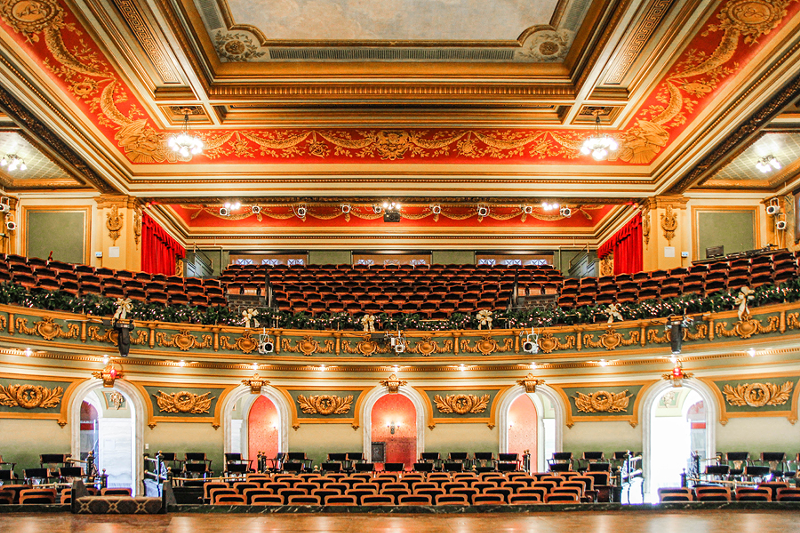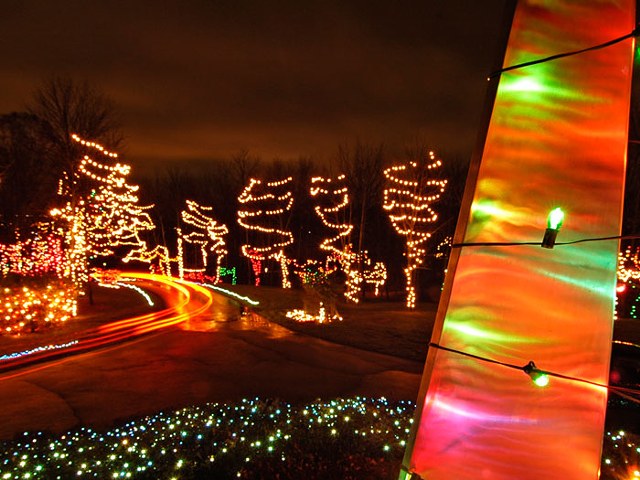Constructed on Elm Street for use by the Grand Army of the Republic — a fraternal group for Union veterans of the Civil War — it was designed in richly luxuriant Beaux Arts style by the Cincinnati architectural firm Samuel Hannaford and Sons. (It also was used by veterans of the 1898 Spanish-American War, a smaller group.)
One of those luxuriant touches can be seen in the second-floor theater, above the stage. In ornate golden lettering on panels in the proscenium arch — one per panel — are the words Unity, Wisdom, Martyrdom, Patriotism, Philanthropy, Integrity, Manliness, Equity and Will. They face the audience as if each was a stern, blunt commandment hurled down from the heavens.
Even stranger than the words themselves is the fact that three of them are punctuated with periods: Unity, Integrity and Equity. “I’m not sure why,” Steele said during a recent tour. “It seems random.”
In the coming months, and well beyond if all goes as planned, probably more people than ever before (at least since the death of the nation’s last Union Civil War veteran in 1956) will have a chance to think about why those once-aspirational words are there while watching events in the theater. Further, the improvements may also position that 555-seat theater as the city’s premium mid-size concert hall at the very moment that demand for comfortable sit-down venues for popular music is growing nationally.
The nonprofit Cincinnati Memorial Hall Society, working with veteran concert promoter John Madden, intends to test the refurbished theater’s potential with the highest-profile event planned for Memorial Hall so far: the new Longworth-Anderson Series. It has booked Rosanne Cash (Feb. 10), Pink Martini (March 9), Richard Thompson (April 7) and Sarah Jarosz (June 9), just nominated for Grammys for Best American Roots Performance and Best Folk Album. All but Pink Martini are acoustic — the belief is Memorial Hall may not be acoustically right for, say, someone loud and raucous like Ozzy Osbourne. The series will have two more concerts this year; it could have as many as 10 in 2018.
“It’s featuring Grammy Award-winning or –nominated acts and bands, but it’s the same intimate hall,” says William Baumann, chairman of the Society, which was founded in 2004 as an advocate for Memorial Hall’s preservation.
“When I was contacting booking agencies about the series, I got frequent comments from people saying, ‘It’s good Cincinnati finally has a small theater we can take a look at.’ Certainly, they recognized this as something the city needed,” Madden adds.
The theater also has something else going for it — cachet among the urban-oriented. When it was the prime site for Bryce Dessner’s MusicNOW Festival, from 2008-13, it forged a modern identity as a home for adventurous and contemporary music. A symbiosis emerged between the festival’s pride in undiscovered music and this beautiful if then-worn underappreciated space. That could help now, whatever the future is for MusicNOW after its 2017 edition at Taft Theatre.
“There’s such a realness to this space,” Baumann says. “People saw it as hip when MusicNOW came and it was magic, really.”
But an even more influential show occurred in May 2013, when Patti Smith appeared for a reverential performance of her music and readings in connection with a Contemporary Arts Center exhibition. She loved the space. “She even commented on the hall,” Baumann says. “That was an inspiration for our trustees about how valuable this hall is and the kind of important performances that could be held there.”
Thus, one key goal of the restoration of the county-owned building is to make Memorial Hall a lynchpin of an emerging cultural arts district along Elm Street in Over-the-Rhine. The restoration was undertaken with that in mind by the nonprofit real estate company Cincinnati Center City Development Corporation (3CDC), which coordinated the majority of the financing and will manage the building; the Society, which raised $2.2 million in private donations; and Hamilton County, which contributed $1.5 million. The building was eligible for federal and state historic tax credits, as well as New Market ones; it has been on the National Register of Historic Places since 1978.
Steele, a 3CDC employee, put it this way at a ribbon-cutting ceremony earlier this month, as he stood at the entrance of the refurbished lobby and faced outward to the crowd of well-wishers and public officials: “Elm Street is truly going to be the epicenter of arts and culture in the city.”
A new streetcar passed at one point. He mentioned, besides Memorial Hall, the under-construction Cincinnati Shakespeare Company theater; the Transept events center, previously a vacant German Gothic church built in 1814; Cincinnati Music Hall, currently undergoing its own $135 million restoration and scheduled to reopen in October 2017; and Washington Park, site of numerous activities — cultural and otherwise — since 3CDC, on behalf of the Cincinnati Park Board, completed a $46 million renovation/redesign of it in 2012.
“We’ve preserved so many fantastic buildings in this neighborhood,” Steele, who formerly ran the theater at Covington’s The Carnegie, said in an interview at his new compact office in Memorial Hall. “But there was this real danger of this falling into disrepair. Since we operate Washington Park, we recognized some opportunities for synergy. We assisted with securing a lot of the financing; we have expertise in construction management and so off we went.”
This will be the first indoor “civic space” that 3CDC manages. (It also programs Fountain Square and Washington Park and has the redesigned Ziegler Park upcoming.) It will also be a space where admission is charged for many events — the first one since reopening, a BRICKmas LEGO display presented by American Legacy Tours, costs $10 to see. (It’s up through Dec. 30.)
“We’re aiming for the venue to be financially self-sustaining,” Steele explained, via email. “While we’d love it to generate a profit, our motive is to activate an important civic space rather than to run a for-profit venue.”
The whole building has gotten updates. There is a new 8-foot addition on the west side that allows for air conditioning and a backstage, finally. There’s a catering kitchen to serve two first-floor ballrooms and a remodeled lower-level studio that can be rented for activities. There will also be three bars in the building.
And the infamous first-floor closet-size restrooms, each of which had just one toilet and thus long lines during events, have been replaced with new ones. The old bathrooms have been preserved, however — one is now a box-office and the other the will-call area.
But the area where the improvements may be most appreciated is the theater. It has always been a beautiful jewel box of a place, much photographed, with its three rows of light bulbs outlining the stage arch and two rear-stage wood-framed windows that opened from the stage wall to the outdoors. With its vividly painted patriotic mural, of an American eagle clutching flags, commanding attention from under the stage’s clamshell ceiling, being there was like watching a show — whether or not there was an actual show to watch.
In years past, quite a few people studied the building’s decorative features while squirming in their chairs during events. The wooden seats were narrow and uncomfortable. Besides the lack of air conditioning, you could also hear sounds from the marble staircases and the first floor during quiet programs. Since people went to the bathroom during performances to avoid the long lines, that created some embarrassing problems. “Someone once told me that when you’re performing on stage, you could hear someone flush the toilet downstairs,” Steele says.
“To address all that, we have dramatically updated our technical capacities,” he says. Among those changes are a new theatrical lighting rig, LED lights and — to improve sound — four clusters of three speakers, a new PA system and a fulltime technician. The stage has been tastefully, demurely remodeled; its windows have been preserved but now just look out to the new backstage.
The seating is also new, but looks old. “What we’ve done to retain the historical character, but make it more acceptable for the modern audience, is to create a new version of our seats,” Steele says. “They’ve actually crafted new wooden seats that look like the old ones, but are wider. And we now have beautiful black upholstery on the backs and seats of all the chairs in the house. We did retain what’s called the standard, the metal portion that separates the chairs, and very amusingly we also kept the hat racks (that are underneath the seats).”
In order to inhibit outside noise from invading the theater, the nonprofit Annie W. & Elizabeth M. Anderson Foundation helped raise money for a theater renovation, which included six sleek and unobtrusive glass doors at entrances. New thick, sound-baffling curtains now block the balcony from the staircases. (The theater has been renamed in their honor.)
Steele also has added a 20-foot projection screen and a 10,000-lumen laser projector in the theater. That’s good enough to lure Cincinnati World Cinema into scheduling some screenings there. The group will present its annual screening of Oscar-Nominated Short Documentary Films on Feb. 11-12 and Oscar-Nominated Live Action and Animated Shorts on March 11-12.
Previously, it had used The Carnegie. “We’ve outgrown The Carnegie,” says Tim Swallow, of the group. “The nice thing about coming into Memorial Hall is that we have a larger number of seats available; there’s room for growth. And we’ll have brand new equipment and a much larger screen.”
Steele has been seeking what he calls “curated partnerships” to get activities into Memorial Hall. “I’m going out into the community and reaching out to groups that have high-quality existing products and an existing audience,” he says. “We add value to their work by bringing them into the hall. They help us activate the space by bringing in an audience.”
Among the “curated partnerships” he so far has booked are the Fringe Festival, ComedySportz and Matinée Musicale Cincinnati recitals (planned for the 2017-18 season). Meanwhile, Steele has also been booking events like the Found Footage (Film) Festival, Kamikaze Fireflies comedy-acrobatic troupe, a Tony Awards party and a production of the immersive Tony n’ Tina’s Wedding, which will move from space to space as the mock ceremony proceeds and which Steele will produce. He’s also hoping to honor the venue’s history as a place for lectures and oratory.
“In the summer, there will be synergy with Washington Park,” Steele says. “We’ll see how we can use Memorial Hall to keep the party going after the park closes at 10 p.m. So on certain Saturday nights, we’ll have cult-classic films so people can come over here, watch them and have a couple of beers and relax.”
Even without those films, that might be the right time and mental state to sit in the painstakingly rehabilitated theater, ponder those periods after Unity, Integrity and Equity, and ask yourself, “Why?”
To view MEMORIAL HALL’s upcoming events schedule and learn more about the recent renovation, visit memorialhallotr.com.






